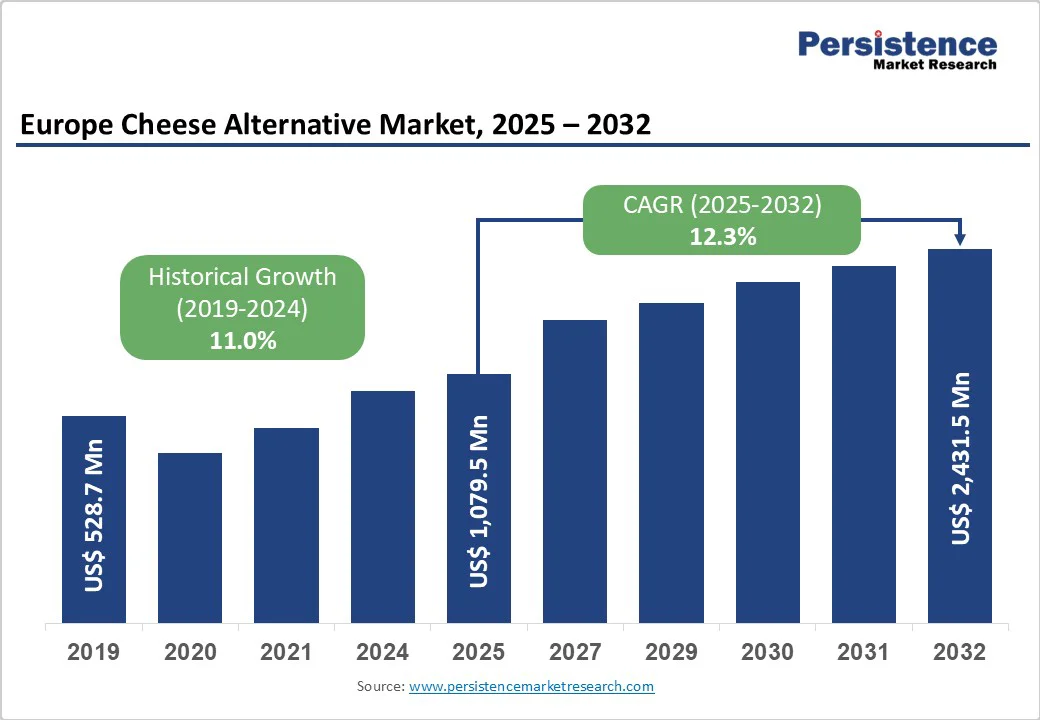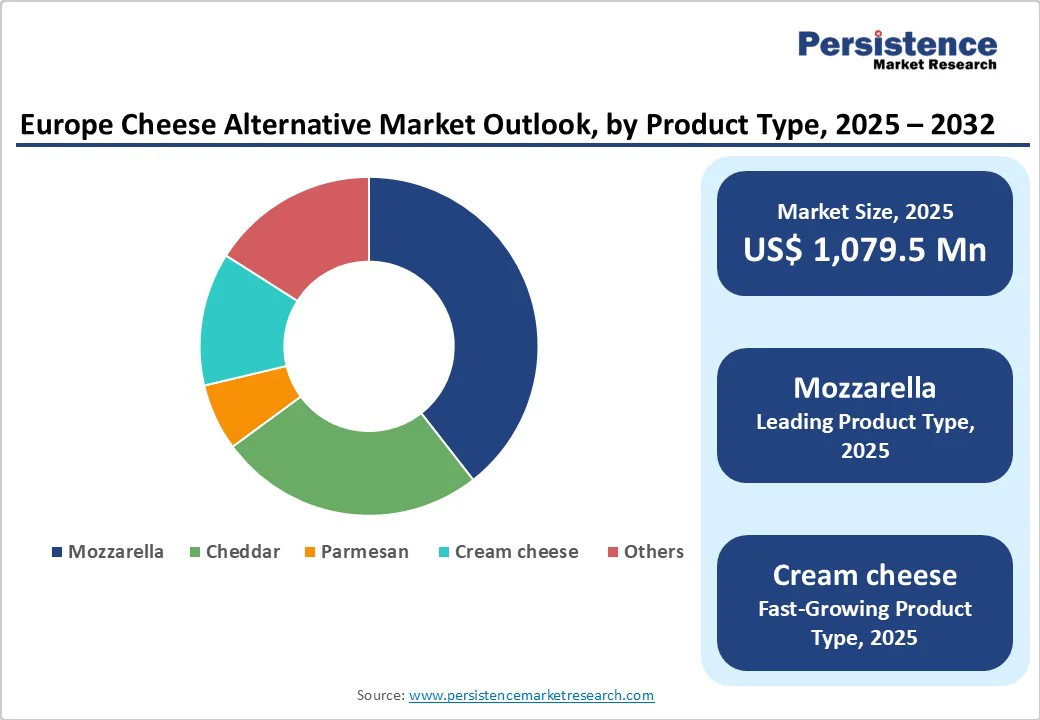ID: PMRREP35716| 192 Pages | 13 Oct 2025 | Format: PDF, Excel, PPT* | Food and Beverages

Europe cheese alternative market size is likely to value US$ 1,079.5 Mn in 2025 and projected to reach US$ 2,431.5 Mn by 2032, growing at a CAGR of 12.3% during the forecast period from 2025 to 2032.
The European cheese alternative market is experiencing rapid growth, driven by an increasing vegan, flexitarian, and lactose-intolerant population. Strong demand in retail and foodservice, particularly for meltable products such as mozzarella, supports expansion.
Innovation in taste, texture, and fortified formulations enhances appeal. Europe leads globally in terms of mature distribution, sustainability policies, and established brands, while the Asia Pacific emerges as a high-growth region.
| Key Insights | Details |
|---|---|
| Europe Cheese Alternative Market Size (2025E | US$ 1,079.5 Mn |
| Market Value Forecast (2032F) | US$ 2,431.5 Mn |
| Projected Growth (CAGR 2025 to 2032) | 12.3% |
| Historical Market Growth (CAGR 2019 to 2024) | 11.0% |

The growth of vegan and flexitarian diets is a significant driver for the European cheese alternative market. According to the European Commission's 2023 Agricultural Outlook, approximately 30% of EU consumers identified as flexitarians in 2021, favoring plant-based foods while occasionally consuming meat and fish.
This dietary shift is further supported by findings from ProVeg's 2023 Smart Protein survey, which indicates that 90% of plant-based consumers are neither strictly vegetarian nor vegan, highlighting the prominence of flexitarianism across Europe.
Additionally, a 2020 survey by ProVeg revealed that cheese alternatives and meat alternatives are among the most popular plant-based food categories, with significant consumer interest in these products. This growing demand for plant-based options is driving the expansion of the cheese alternative market in Europe.
The taste and texture gap remains a significant restraint for the European cheese alternative market. A European consumer survey revealed that plant-based cheese was the category least favored in terms of taste and texture, with consumers expressing a desire for improvements to replicate the characteristics of dairy cheese better.
Additionally, a systematic review of 85 sensory studies highlighted that the absence of casein in plant-based cheese often results in undesirable textures such as brittleness or gumminess, and the use of plant-based fats and proteins can lead to phase separation and weak cohesion, affecting sensory quality. These sensory challenges contribute to lower consumer acceptance and hinder the widespread adoption of plant-based cheese alternatives in Europe.
Product innovation and diversification present significant opportunities for the European cheese alternative market, driven by evolving consumer preferences and technological advancements. The European Commission's 2023 Agricultural Outlook reports a shift in EU consumption patterns, with a projected growth in plant protein consumption, indicating a move towards plant-based diets and novel uses of dairy alternatives.
Additionally, the EU-funded DELICIOUS project aims to develop affordable, tasty, and nutritious plant-based dairy alternatives, such as cheese and kefir, by combining microbial products with plant-based materials. This initiative focuses on high-protein products enriched with vitamins, fibers, and probiotics, addressing consumer demand for healthier options.
Furthermore, the FlavourFerm project seeks to optimize fermentation techniques to enhance the flavor of plant-based foods, including cheese, by refining precision, biomass, and traditional fermentation methods. These efforts underscore the growing emphasis on innovation to meet the increasing demand for diverse and appealing plant-based cheese alternatives in Europe.
Mozzarella led the European market with a 33.0% share in 2025, due to its versatility and strong integration into everyday cuisine. It is the most commonly used cheese in pizzas, sandwiches, and baked dishes, making it highly recognizable and acceptable to consumers transitioning to plant-based options.
According to data from the European Union’s agricultural and food consumption reports, cheese is the top dairy product consumed in Europe, and mozzarella represents a significant share of household and foodservice usage. Its functional properties, such as meltability, stretch, and creamy texture, are easier to replicate with plant-based formulations compared to harder cheeses like cheddar or parmesan.
Moreover, the growing demand for lactose-free and vegan diets, especially in countries such as Italy, Germany, and the UK, has further reinforced mozzarella’s position as the preferred plant-based cheese alternative, bridging taste familiarity with dietary preferences.
Cashew Source leads the European market with a 38.5% share in 2025, due to its superior texture, nutritional profile, and consumer acceptance. Cashews provide a creamy base that closely mimics the mouthfeel of traditional dairy cheese, making them ideal for crafting meltable, spreadable, and aged cheese alternatives. This versatility has led to widespread adoption among both artisanal producers and large-scale manufacturers.
For instance, Spain-based company Quevana has established one of Europe's largest cashew cheese production facilities, underscoring the ingredient's central role in the sector. Additionally, the European Union is the largest importer of cashew nuts globally, accounting for approximately 40% of the global cashew import value in 2022. This robust supply chain supports the growing demand for cashew-based products, including cheese alternatives, aligning with the region's increasing preference for plant-based diets and sustainable food options.

Germany’s cheese alternative market is experiencing strong momentum as shifting dietary habits, sustainability concerns, and declining dairy consumption influence consumer choices. Traditional milk and cheese consumption has been steadily declining, while plant-based options are gaining visibility in supermarkets and foodservice establishments.
Consumers are increasingly attracted to innovative formulations that improve taste and texture, addressing one of the long-standing challenges of dairy-free cheese. Precision fermentation is also generating interest, with many Germans open to trying and even paying more for products developed with advanced technology.
Retail presence has expanded quickly, with plant-based cheese now a regular feature in major supermarket chains. This transformation reflects broader consumer awareness around health, lactose intolerance, animal welfare, and environmental impact, driving adoption across flexitarian and vegan segments.
The European cheese alternative market is growing through innovations in flavors, textures, fortified nutrients, and meltable formulations. Leading brands focus on enhancing taste and nutrition, while emerging players prioritize organic and allergen-free options. Café partnerships, retail and e-commerce expansion, and sustainable packaging boost accessibility and appeal, driving broader consumer adoption and strengthening market competitiveness across Europe.
Europe cheese alternative market is projected to be valued at US$ 1,079.5 Mn in 2025.
Rising vegan, flexitarian, and lactose-free diets, health awareness, sustainability trends, product innovation, and increased retail and foodservice availability drive growth.
Europe cheese alternatives market is poised to witness a CAGR of 12.3% between 2025 and 2032.
Product innovation, fortified formulations, niche organic options, café collaborations, e-commerce expansion, sustainable packaging, and rising consumer demand present major market opportunities.
Major players in the global are Mondarella, Simply V, Violife, Bedda, New Roots, Happy Cashew, and Others.
| Report Attribute | Details |
|---|---|
| Historical Data/Actuals | 2019 - 2024 |
| Forecast Period | 2025 - 2032 |
| Market Analysis |
|
| Country Coverage |
|
| Segmental Coverage |
|
| Competitive Analysis |
|
| Report Highlights |
|
By Product Type
By Source
By Form
By Distribution Channel
By Country
Delivery Timelines
For more information on this report and its delivery timelines please get in touch with our sales team.
About Author